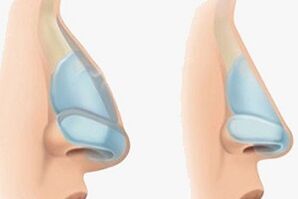
What is rhinoplasty or nasal surgery?
This is one of the most widespread and ancient plastic surgeries (first performed in 1000 BC) in the world.
It represents the entire part of reconstructive surgery that combines surgical correction methods of the shape and size of the nose by replacing congenital or acquired defects in this part of the face with cartilage tissue taken from the patient.
Nose surgery changes the patient and is considered one of the most effective methods to change the appearance.
Types and instructions for
The nose is an olfactory organ, which has a very complex anatomical structure. Surgical correction on this part of the body is considered one of the most difficult plastic surgeries in the world, as doctors not only have to change its appearance, but also to maintain its function (in some cases, such procedures cause curvature of the osteochondral septum, causing nasal breathing difficulties orloss of odor). Therefore, before performing it, surgeons recommend that their clients think carefully and answer the question of whether or not to perform rhinoplasty (exceptions are cases when the irregular shape of the nose causes respiratory disorders and can lead to brain oxygen starvation). The optimal age to perform is 20-30 years, but in case of respiratory problems or after a severe physical injury, it is done earlier.
Key instructions:
- unbalanced size of the respiratory organs in relation to the whole face;
- turbinate hypertrophy;
- injury or deformation to bone or cartilage tissue in the area of the osteochondral septum, its curvature;
- tip of nose asymmetrical, branched or too high;
- "Bonggol";
- lack or difficulty breathing;
- dissatisfaction with previous plastic results.
There are several types of rhinoplasty, which are classified depending on the purpose and technique of the procedure:
- plastic tip of the nose - a method of surgical correction of the shape or removal of asymmetry (bifurcation) of the tip of the nose;
- grafting (autotransplantation) - during the procedure, the doctor enlarges and, if necessary, lengthens the nose too small by transferring cartilage tissue taken from the auricle area;
- reduce - a method of surgical intervention, aimed at correcting the shape and size of the turbinate;
- posterior alignment - removal of bumps on the back of the nose;
- septoplasty - a surgical method of correcting a deviated nasal septum;
- augmentation - a surgical method of correcting the shape of the nasal bridge to eliminate the effect of "leveling";
- non -surgical rhinoplasty - correction of the shape, size and proportions of the nose without surgery by injecting fillers (nasal contour plast), the use of hormonal resorbonal drugs that destroy cartilage tissue in the nasal septum, or with the help of Aptos Thread (lifting the wings and tip of the nose).
How to prepare for surgery?
Before the procedure, the patient needs to visit a plastic surgeon who will perform respiratory organ measurements, determine the amount of work to be done, simulate the results of the operating assumptions on a computer using a special program (computer modeling helps the doctor to better understand the client's wishes) and write references for the following tests:
- general and clinical blood tests;
- electrocardiogram (with decoding);
- fluorography;
- analysis for AIDS, HIV or hepatitis;
- paranasal sinus tomography.
Two weeks before the procedure, you must stop smoking and stop taking blood -thinning medications. Food or drink is not allowed 12 hours before the operation (light dinner is allowed the night before).
Before the procedure, doctors recommend getting good rest and sleep (this will help calm the nervous system).
The technique depends on the method
Immediately before the procedure, the client signs an agreement with the plastic surgery clinic, which contains his consent for the surgery, the cost of the procedure and its type, the names and surnames of the anesthetist and plastic surgeon, and information that the patient is aware of possible postoperative complications and methods. After this, the person is taken to the operating room, the face is cleaned with lotion, the piercing is removed (if any) and, if necessary, a preoperative mark is made with a special marker. The operation is performed under general intravenous or endotracheal anesthesia and lasts 1-2 hours.
There are two methods of performing rhinoplasty: open and closed.
Open rhinoplasty
Open rhinoplasty is a procedure in which a doctor makes an incision in the columella (the part of the skin that lies between the openings of the nose), corrects the shape of the nasal structure, and finally places some cosmetic stitches on the skin. This method of surgical intervention is used to correct serious injuries and deformities of the nasal cavity, and to reconstruct bone and cartilage tissue using autograft.
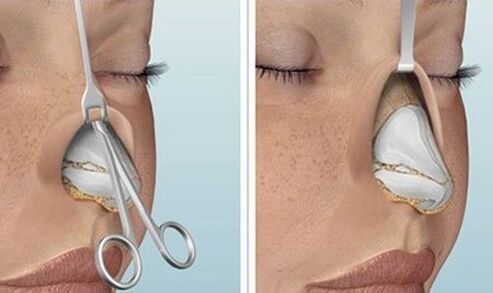
Closed rhinoplasty
Closed rhinoplasty is a procedure in which the surgeon makes an incision in the nasal cavity, separates the soft tissue from the osteochondral skeleton, performs a series of surgical procedures to change the shape of the nose, and then sews the mucous membrane with self -absorbing sutures of the material. Less traumatic plastic surgery methods, after which complications are rare and scars are still present.
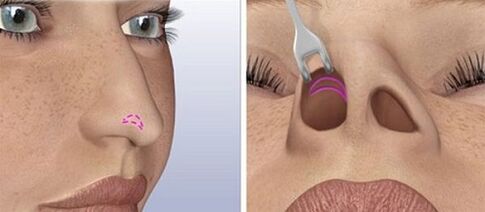
After the first unsuccessful operation or in the event of a consequence that does not suit the client, the doctor performs a second (secondary) rhinoplasty. This is a more complex procedure (technically) that requires the skills and practical experience of the surgeon, it is performed under general anesthesia and requires the same preparation as the main plastic. It is performed no earlier than one year after the previous surgical intervention.
Duration and outcome of recovery
The recovery period lasts 3-4 weeks, but the patient spends one day in the hospital. Immediately after surgery, a tampon is inserted into each nostril, which is removed by the surgeon after three days, and a sticker is affixed to the nose (it is removed after ten days). After removing the tampon, the doctor prescribes drops to the patient to relieve postoperative edema and speed up soft tissue healing. Swelling and bruising disappear completely after 1. 5-2 months. The initial result is assessed after 6-8 months, the final result - after 12. Scars after rhinoplasty can be seen for the first three months, then it becomes almost invisible.
Postoperative recommendations:
- two weeks after surgical correction, you must sleep on your back;
- for the first few weeks, you can not visit the sauna, swimming pool, solarium, gym and do heavy physical work;
- until the wound after surgery is completely healed, you can only eat warm food and drink warm drinks;
- You should not wear glasses for 2-3 months after the procedure;
- during the recovery period, you should not smoke.
Results of rhinoplasty or nasal surgery: before and after photos
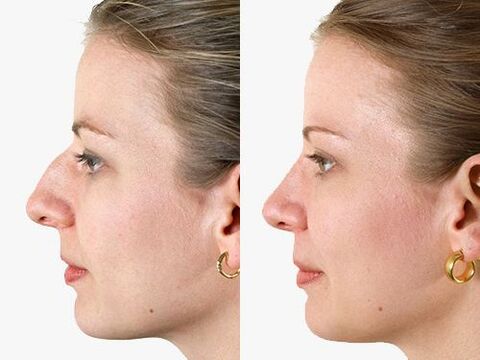
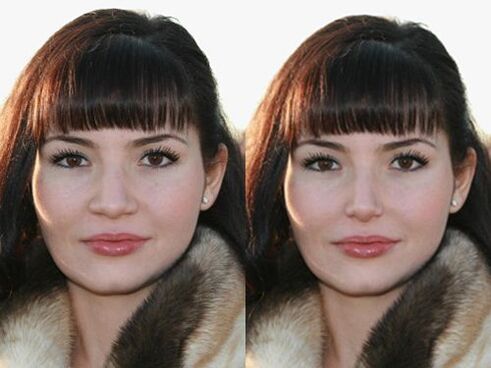
Possible complications and contraindications
Contraindications to running:
- oncology;
- runny nose;
- the flu, SARS;
- active herpes;
- diabetes;
- atrophic rhinitis;
- infectious diseases of the oral cavity;
- mental disorder;
- dry cough;
- heart and kidney disorders.
Rhinoplasty is referred to as one of the most difficult plastic surgeries in the world, where surgeons often do not remove one, but several cosmetic defects at once, therefore, it is associated with the development of several possible complications:
- nosebleeds;
- postoperative pigmentation;
- swelling and hematoma of soft tissues;
- loss of odor;
- the appearance of keloid scars;
- hard to breath;
- curvature of the nasal septum.
What operations can be combined?
Often, nasal plasticity is combined with septoplasty - surgery to correct the nasal septum (this procedure is sometimes called septorhinoplasty), cheiloplasty (changing the shape and volume of the lips) and mammoplasty - plastic surgery aimed at improving the shape and size of the breast (in the latter case, two doctorspresent in surgery, one of them performing rhinoplasty, and the other performing breast plastic surgery).
Estimated price for rhinoplasty (nose job)
Plastic surgeons provide accurate information on how much nasal surgery costs. The cost of rhinoplasty includes initial consultation, hospital stay, computer simulation of results, tampon removal and bandage removal. The price of the procedure depends on the type and method of surgical intervention.
Rhinoplasty is an equally popular operation among women and men. It helps people get rid of health problems, improve the appearance and facial features.




















